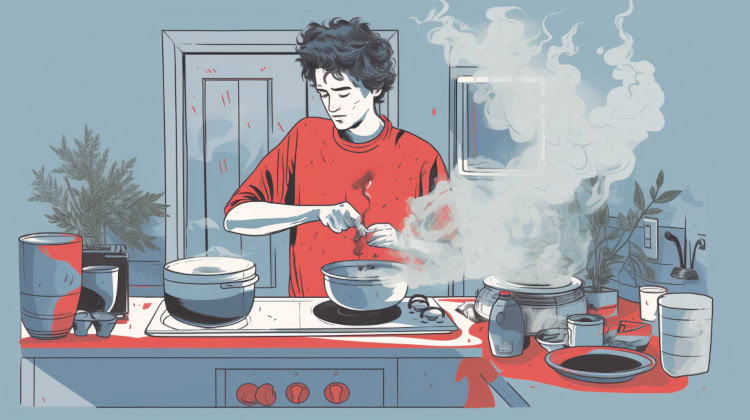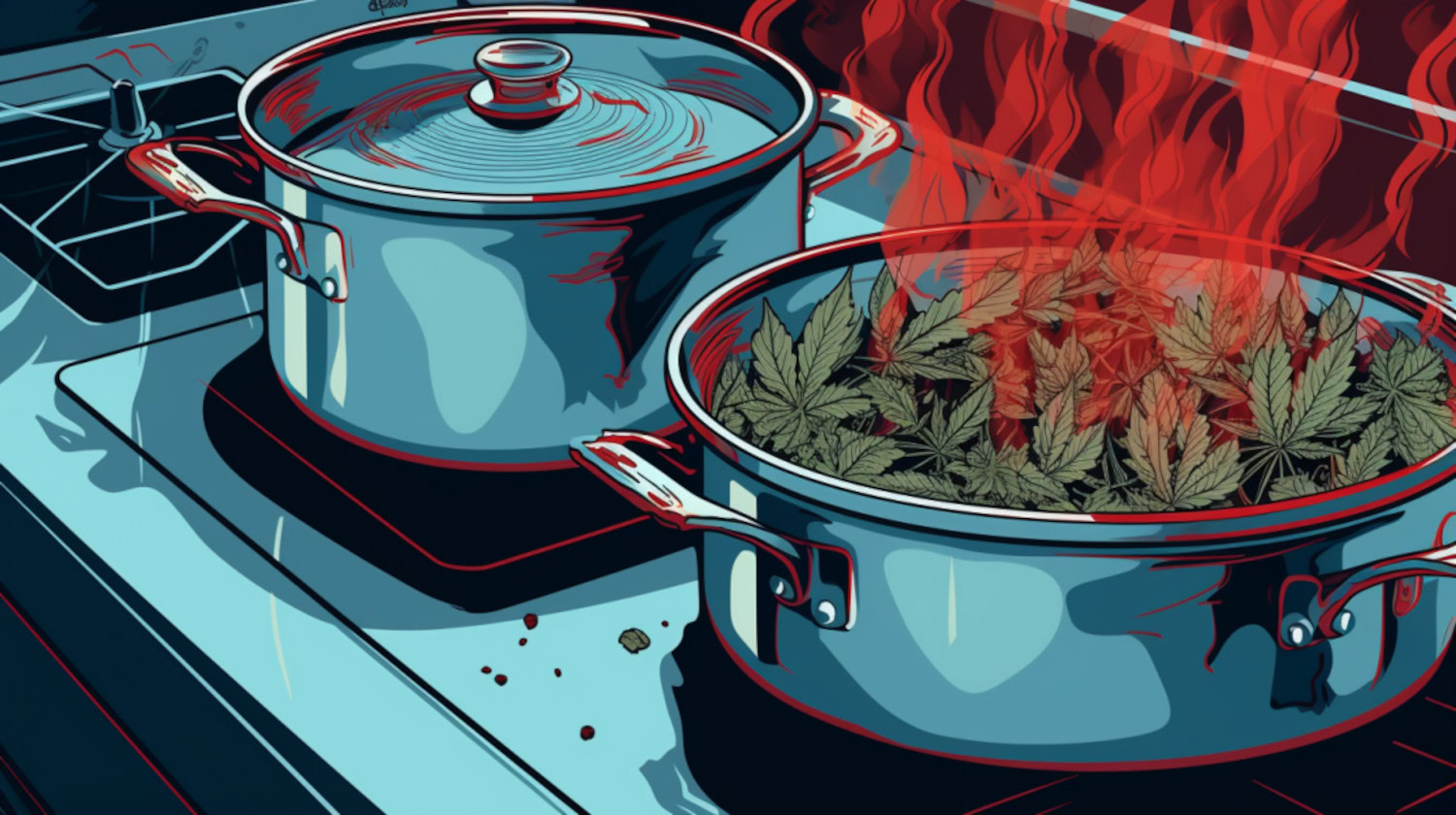Key Takeaways
- Boiling cannabis is an effective way to decarb dry flower.
- Decarbing flower by boiling can preserve the integrity of the cannabis including quality of terpenes and cannabinoids.
- To boil weed: Bring a pot to a steady boil > Place cannabis in a heat-resistant bag in the water > Simmer for 90 min > Cool.
Learning how to decarb cannabis flower properly is a crucial step in making homemade edibles and other infused products.
While decarbing cannabis at home can be done relatively easily with cannabis flower, a baking sheet, and a stove, some mishaps are common. Mistakes while debarbing can lead to potency loss, burnt nugs, and terpene degradation.
So, in the search for the optimal way to decarb cannabis at home, many consumers beg the question: can you boil weed to activate it?
What's the Truth? Can You Boil Weed to Activate It?
Decarbing weed relies on two primary factors: time and heat.
Decarbing cannabis flower by boiling it is achievable if done correctly. Research suggests that the average duration and optimum temperature required to decarb THCA is 235°F for 65 minutes or 278°F for 57 minutes.1
What is THCA?
THCA is the abbreviation for “tetrahydrocannabinolic acid” - a non-intoxicating cannabis element that becomes psychoactive once heated into its precursor form, THC. If you're decarbing CBD-rich weed, cannabidiolic acid (CBDA) is the precursor you'll be transforming.
This is important to note because THCA and CBDA will not cause any intoxicating effects. They may, however, provide neuroprotective and other effects.2,3
How to Boil Weed
Despite being a fairly hands-on way to decarb flower, top cannabis chefs favor the boiling method for its efficacy and reliability. The process involves the following steps:
- Heat a large pot of water steadily until boiling.
- Submerge a zip-locked or vacuum-sealed bag filled with cannabis flower into the boiling water. (Confirm the bag is heat-resistant before exposing it to high temperatures.)
- Simmer for 90 minutes.
- Allow the bag to cool before opening it gently.
Also known as “sous vide decarb,” the boiling weed decarboxylation technique is recommended if you don't want to risk damaging your cannabis to the point of no return. Water does not exceed 212° F at boiling point, so it’s highly unlikely to burn your stash.
For those concerned about the smell put off by decarbing cannabis, boiling it in an air-tight container or turkey bag will reduce the pungent aromas. Decarbing cannabis won't cause flavor loss if you apply low heat, which will also help terpene preservation.
What are the Benefits of Boiled Weed?

Cannabis is a fragile plant, especially during the decarbing process. Excessive or improper exposure to heat can damage essential compounds like cannabinoids and terpenes, thereby affecting potency and flavor. Inexperienced cannabis “decarbers'' should be mindful about burning their cannabis while using methods like baking it.
When boiling cannabis, the flower is encased in a heat-proof bag so it is not directly exposed to the heat source. Boiling cannabis can help ensure delicate trichomes and terpenes go unscathed. It is often an effective decarbing method for those who want to retain as much of the cannabis strain's aromatics as possible.
Other decarb methods may neutralize cannabinoids (like THC) instead of unlocking their true potential, but sous vide decarb is fairly risk-free. To reduce the risk of damaging the cannabis flower, practice caution to ensure that the airtight bag is heat-resistant.
Does Boiling Weed Make it Smell?
The fragrance of cannabis is often a sensory delight for some consumers, but it can be unpleasant for others. Fortunately, the odor from boiling cannabis is much less noticeable than if decarbing flower in an oven.
While the sous vide decarb method is not entirely odor-free, the scent is minimal and usually dissipates quickly. Since the cannabis will boil inside an air-tight package, terpenes are less likely to permeate the air.
To further reduce any overpowering smells, keep the cooking space well-ventilated and open the bag near a window. When choosing the oven to decarb, consumers ought to prepare for any unwanted odors by further learning how to get rid of the smell of cannabis.
What is the Lowest Temperature for Decarboxylation?

The typical temperature guideline for cannabis decarboxylation is 200-245ºF, with 220ºF being the sweet spot.1 Sunlight may degrade cannabis terpenes, which is why it is advisable to store raw and decarbed flower in a cool, dry place for potency preservation.
When decarbing cannabis flower, stick to the lower end of the heat spectrum to achieve optimal results. This is often best accomplished using water-based decarboxylation methods, such as sous vide and Mason jars.
Alternatively, consumers can use a device like Ardent, which is professionally designed to run at 176 degrees F° for 1-2 hours, to avoid destroying fragile cannabinoids and terpenes. Hotter decarb methods include ovens and toaster ovens.
How Do You Decarb Weed in a Jar?
Decarbing cannabis in a jar can help to minimize the chances of unwanted odors infiltrating the house and clothes.
A typical mason jar works perfectly and has no mess. Since mason jars are created using tempered glass, they can withstand extreme heat up to 392°F. These glass containers are microwave-safe, but always exercise caution when handling hot jars and avoid placing them on surfaces that are susceptible to melting.
To decarb weed in a jar, you will need a mason jar, a half-filled pot of water, a pair of gloves, and some cannabis to follow these decarb steps:
- Break, grind, or scissor-cut the cannabis into rice-sized pieces.
- Fill the mason jar with cannabis and screw the lid shut.
- Pour water into a pot until half-full before gently placing the jar inside.
- Slowly simmer on low-medium heat. If the jar is immediately immersed in boiling water, it may crack. Please be cautious.
- Simmer for 90 minutes, then turn off the heat once the timer sounds.
- Carefully remove the jar (while wearing gloves) and place it on a heat-proof surface.
- Allow to cool for 30 minutes before storing or using!
The mason jar decarb method is a version of boiling weed similar to the sous vide decarb method, but instead of a bag, it uses a cannabis-filled mason jar submerged into a pot of boiling water. The removable lid ensures no leakage when sealed airtight. This design will keep the cannabis in its optimal state for consumption.
What is Boiled Weed Good For?

Decarboxylated cannabis, which is activated via the boiling technique, has widespread uses for both edible and non-edible products.
Decarbed flower is ready for consumption and suitable for any type of infused cannabis concoction. You will, however, need to take subsequent steps to achieve the finished product, such as infusing it into other ingredients like oils or kinds of butter. The amount of work involved depends on which recipe or product type you choose.
Examples of some uses for decarboxylated cannabis include:
- Edibles—Edible consumption is the easiest way to use decarboxylated cannabis. Types of edibles include candy-flavored lozenges, herb mayonnaise, vegan cannabutter, gummy bears, maple pancakes, and even infused falafel burgers. The effects of edibles can linger anywhere from 2 to 24 hours, depending on metabolism, tolerance, etc. Using a dosage calculator to make THC or CBD edibles allows for controlled dosing.
- Topical Solutions—Post-decarb cannabis contains active cannabinoids that the skin can absorb before entering the bloodstream. Simply combine the decarbed flower with your choice of oil (e.g., coconut, almond, or olive oil) and blend with a preferred essential oil to make a long-lasting topical balm or salve.
- Oils and Tinctures—Make oils and tinctures to enjoy the benefits of active cannabinoids. Measure your desired ratio of fat-soluble oil to cannabis.
- Capsules—For therapeutic results, consider adding either infused oil or decarboxylated dry cannabis flower to capsules. Oil capsules may be easier to digest.
Remember to store your decarbed and infused cannabis properly. Consider reusing your Mason jar to lock in freshness and extend shelf life. Store in a cool, dry place away from direct sunlight, moisture, and heat.
References
- Reason DA, Grainger MNC, Lane JR. Optimization of the Decarboxylation of Cannabis for Commercial Applications. Industrial & Engineering Chemistry Research. 2022;61(23):7823-7832. doi:https://doi.org/10.1021/acs.iecr.2c00826 ↩︎
- Moreno-Sanz G. Can You Pass the Acid Test? Critical Review and Novel Therapeutic Perspectives of Δ9-Tetrahydrocannabinolic Acid A. Cannabis and Cannabinoid Research. 2016;1(1):124-130. doi:https://doi.org/10.1089/can.2016.0008 ↩︎
- Walsh KB, McKinney AE, Holmes AE. Minor Cannabinoids: Biosynthesis, Molecular Pharmacology and Potential Therapeutic Uses. Frontiers in Pharmacology. 2021;12. doi:https://doi.org/10.3389/fphar.2021.777804 ↩︎
The information in this article and any included images or charts are for educational purposes only. This information is neither a substitute for, nor does it replace, professional legal advice or medical advice, diagnosis, or treatment. If you have any concerns or questions about laws, regulations, or your health, you should always consult with an attorney, physician or other licensed professional.




